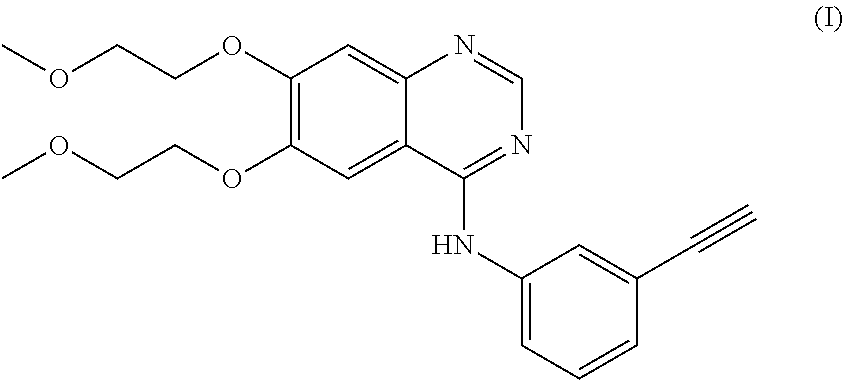Process for the preparation of erlotinib
a technology of erlotinib and erlotinib, which is applied in the field of erlotinib synthesis process, can solve the problem of not being able to activate cell reactions, and achieve the effect of reducing the number of active ingredients
- Summary
- Abstract
- Description
- Claims
- Application Information
AI Technical Summary
Problems solved by technology
Method used
Image
Examples
example 1
[0033]In a reaction flask, 2-amino-4,5-bis(2-methoxyethoxy)-benzonitrile (37.01 g, 0.139 mol) and acetonitrile (185 ml) were charged; 3-ethynylaniline hydrochloride (30.00 g, 0.195 mol), trifluoroacetic acid (17.43 g, 0.152 mol) and formamidine acetate (15.19 g, 0.145 mol) were added to the resultant mixture. The reaction mixture was brought to the reflux temperature of the solvent and maintained under such conditions for about fifteen hours. At the end of the reaction, the temperature was brought to about 25° C., the solvent was removed by distillation under vacuum and methylethylketone (430 ml) was added. The organic phase was washed with a saturated sodium bicarbonate solution (2×100 ml) and with water (2×100 ml). The collected organic phases were concentrated to residue by distillation under vacuum.
[0034]The resultant raw product was suspended in ethyl acetate (450 ml) and a solution of hydrochloric acid at 37% (14.38 g, 0.145 mol) was added, maintaining the temperature at 15° C...
example 2
[0035]In a reaction flask, 2-amino-4,5-bis(2-methoxyethoxy)-benzonitrile (37.01 g, 0.139 mol) and acetonitrile (185 ml) were charged; 3-ethynylaniline hydrochloride (30.00 g, 0.195 mol), trifluoroacetic acid (17.43 g, 0.152 mol) and formamidine acetate (15.19 g, 0.145 mol) were added to the resultant mixture. The reaction mixture was brought to the reflux temperature of the solvent and maintained under such conditions for about fifteen hours. At the end of the reaction, the temperature was brought to about 25° C., the solvent was removed by distillation under vacuum and methylethylketone (430 ml) was added. The organic phase was washed with a saturated sodium bicarbonate solution (2×100 ml) and with water (2×100 ml). The collected organic phases were concentrated to residue by distillation under vacuum.
[0036]The resultant raw product was suspended in ethyl acetate (450 ml) and benzylamine hydrochloride (20.82 g, 0.145 mol) was added, maintaining the temperature at 15° C. for about t...
example 3
[0037]In a reaction flask, 2-amino-4,5-bis(2-methoxyethoxy)-benzonitrile (37.01 g, 0.139 mol) and acetonitrile (185 ml) were charged; 3-ethynylaniline hydrochloride (30.00 g, 0.195 mol), trifluoroacetic acid (17.43 g, 0.152 mol) and formamidine acetate (15.19 g, 0.145 mol) were added to the resultant mixture. The reaction mixture was brought to the reflux temperature of the solvent and maintained under such conditions for about fifteen hours. At the end of the reaction, the temperature was brought to about 25° C., the solvent was removed by distillation under vacuum and methylethylketone (430 ml) was added. The organic phase was washed with a saturated sodium bicarbonate solution (2×100 ml) and with water (2×100 ml). The collected organic phases were concentrated to residue by distillation under vacuum.
[0038]The resultant raw product was suspended in ethyl acetate (450 ml) and trimethylamine hydrochloride was added, maintaining the temperature at 15° C. for about thirty minutes. The...
PUM
| Property | Measurement | Unit |
|---|---|---|
| temperature | aaaaa | aaaaa |
| temperature | aaaaa | aaaaa |
| aprotic polar | aaaaa | aaaaa |
Abstract
Description
Claims
Application Information
 Login to View More
Login to View More - R&D
- Intellectual Property
- Life Sciences
- Materials
- Tech Scout
- Unparalleled Data Quality
- Higher Quality Content
- 60% Fewer Hallucinations
Browse by: Latest US Patents, China's latest patents, Technical Efficacy Thesaurus, Application Domain, Technology Topic, Popular Technical Reports.
© 2025 PatSnap. All rights reserved.Legal|Privacy policy|Modern Slavery Act Transparency Statement|Sitemap|About US| Contact US: help@patsnap.com



